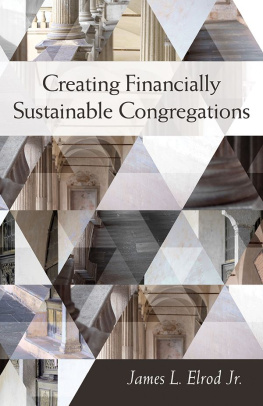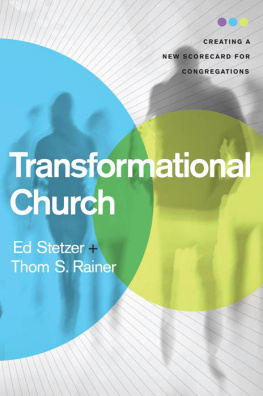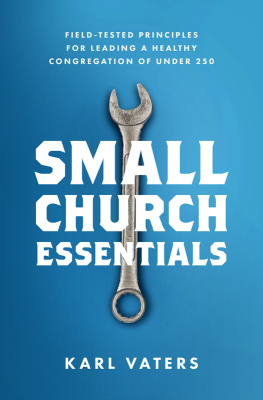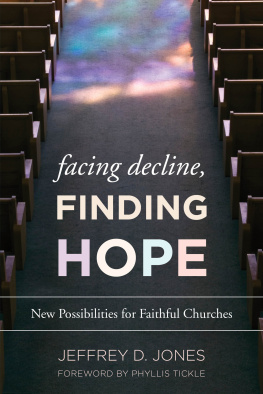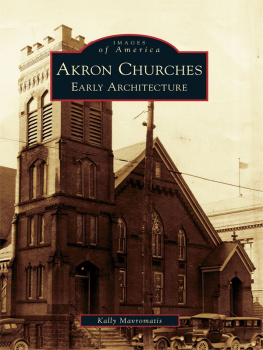Creating Financially
Sustainable Congregations
Creating Financially
Sustainable Congregations
James L. Elrod Jr.

Copyright 2021 by James L. Elrod Jr.
All rights reserved. No part of this book may be reproduced, stored in a retrieval system, or transmitted in any form or by any means, electronic or mechanical, including photocopying, recording, or otherwise, without the written permission of the publisher.
All Scripture quotations, unless otherwise indicated, are taken from the Holy Bible, New International Version, NIV. Copyright 1973, 1978, 1984, 2011 by Biblica, Inc. Used by permission of Zondervan. All rights reserved worldwide. www.zondervan.com. The NIV and New International Version are trademarks registered in the United States Patent and Trademark Office by Biblica, Inc.
Church Publishing
19 East 34th Street
New York, NY 10016
www.churchpublishing.org
Cover design by Jennifer Kopec, 2Pug Design
Typeset by Denise Hoff
Library of Congress Cataloging-in-Publication Data
Names: Elrod, James L., author.
Title: Creating financially sustainable congregations / James L. Elrod Jr.
Description: New York, NY : Church Publishing, [2021] | Includes bibliographical references.
Identifiers: LCCN 2021000120 (print) | LCCN 2021000121 (ebook) | ISBN 9781640652873 (paperback) | ISBN 9781640652880 (epub)
Subjects: LCSH: Church finance.
Classification: LCC BV770 .E47 2021 (print) | LCC BV770 (ebook) | DDC 254/.8--dc23
LC record available at https://lccn.loc.gov/2021000120
LC ebook record available at https://lccn.loc.gov/2021000121
This book is for clergy, lay leaders, and church members who have decided that when it comes to money and church, avoiding hard conversations is no longer acceptable. It is a book for those who realize the task of bringing into place a financial infrastructure capable of sustaining their church is ultimately their responsibility and they want to do something about it. Whether their most pressing problem is securing space in an industrial park to plant a new church or creating a realistic budget, certain bedrock financial principles always apply. Creating Financially Sustainable Congregations can help facilitate more productive conversations among church leaders about what is required to create or recreate a financially sustainable church in the third decade of the twenty-first century.
This book will give some readers a better sense of the context in which churches operate in this new millennium. Much has changed in the first two decades of the twenty-first century in the area of church finance. The playbook on church financial matters that served many churches well during the final decades of the twentieth century has become obsolete. Creating Financially Sustainable Congregations is an update from the front, aimed at providing church leaders with information they need to set their financial house in order and position their church for success.
The challenges brought on by these structural changes in church finance have been amplified by a series of external economic shocks. As this text goes to press, the pandemic of Covid-19 rages on. During 2020, Covid-19 profoundly and negatively affected fundraising for many churches. This threat to their primary source of revenue has obvious implications for a congregations near-term financial stability. And yet doing whats necessary just to keep the doors open isnt enough. How can a church respond to immediate financial threats while simultaneously bringing into place the processes and systems that will better position it to flourish once todays crisis has passed?
What Youll Find Inside
Chapter 1 explains why church leaders often find it difficult to discuss their congregations financial situation. Most clergy do not receive formal training in financial matters. Lay leaders who may be familiar with commercial financial issues dont appreciate the peculiarities of the nonprofit financial world in which a church operates. Consequently, conversations among church leaders regarding financial matters can be disjointed and unproductive. This situation needs to be acknowledged before it can be resolved.
Chapter 2 describes differences in terminology that can make financial conversations about churches difficult. Unlike other nonprofit organizations, churches arent required to report their financial results to the federal government. This means there is no comprehensive, accessible database on church financial performance. With no comprehensive, accessible database, church leaders find comparing the performance of their church to others is often impossible.
Chapter 3 is an overview of essential nonprofit accounting and reporting practices. This chapter was written for clergy and lay leaders who have no formal training in finance. You will learn how the four basic financial reports that comprise the audited financial statements of a church work and how they interact with one another. Standard financial information, however, may not tell the full story of a congregations financial journey. Church leaders need to consider whether their church would benefit by creating additional content and distributing financial information beyond whats required.
Chapter 4 describes how a church accesses financial capital so it can grow its mission. Churches, like other nonprofit organizations, have limited access to outside capital. Understanding the challenges churches face in creating permanent capital is the key to understanding what must be done to create a financially sustainable enterprise.
Chapter 5 highlights the issues churches encounter with budgets and budgeting. Nimi Wariboko, a former faculty member at Andover Newton Seminary, famously proclaims, Budget is theology. A budget describes a congregations near-term plan for living life together in faith. The process of budgeting, not just the budget document itself, is an integral part of a sustainable mission and an act of faith. Budgets and budgeting are critical contributors to the process of building the churchs permanent capital base discussed in chapter 4.
Chapter 6 describes todays philanthropic landscape. Americans are among the worlds most generous people. How Americans express that generosity, however, is changing. The percentage of gifts to religious organizations continues to decline. Moreover, the philanthropic landscape itself is changing rapidly. The consequences for church fundraising over the next ten years will be profound.
Chapter 7 considers generational differences in charitable giving. It is closely linked to some of the developments highlighted in chapter 6. The so-called Baby Boom generation provides the majority of the financial support to nonprofit organizations today. This will no longer be true by 2030. How does a church maintain the financial engagement of its Boomer members, whose gifts keep the doors open today, while cultivating the financial support of Gen Xer members, whose gifts will be the key to maintaining financial sustainability in the not-too-distant future?
Chapter 8 highlights the special challenges encountered by churches in financial crisis. As church leaders who lived through the coronavirus pandemic learned, financial crises experienced by a church often begin outside the church walls. A church cant immunize itself from financial crisis because the crisis is the byproduct of events outside the churchs control. Successfully managing through a financial crisis calls for a different style of leadership than whats needed during times of financial stability.

